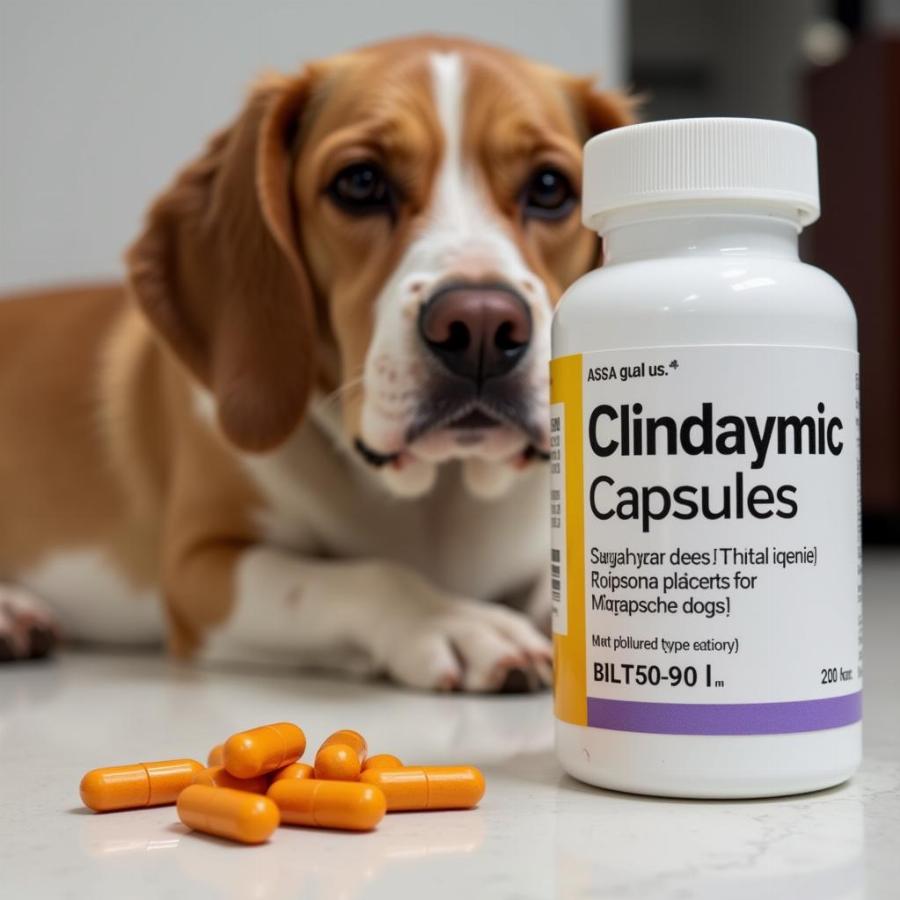Clindamycin dosage for dogs by weight is a crucial aspect of responsible pet ownership. Administering the correct dosage is vital for effectively treating infections while minimizing the risk of side effects. This comprehensive guide will explore the appropriate clindamycin dosage for dogs, potential side effects, and important considerations for safe and effective usage.
Understanding Clindamycin for Dogs
Clindamycin is an antibiotic belonging to the lincosamide class, often prescribed to treat various bacterial infections in dogs, such as skin infections, bone infections, and dental abscesses. It works by inhibiting bacterial protein synthesis, effectively halting the growth and spread of the infection.  Viên nén Clindamycin dành cho chó However, it’s crucial to remember that clindamycin is not effective against viral or fungal infections. Misuse can lead to antibiotic resistance, making future infections more difficult to treat. Therefore, always consult with a veterinarian before administering any medication to your dog.
Viên nén Clindamycin dành cho chó However, it’s crucial to remember that clindamycin is not effective against viral or fungal infections. Misuse can lead to antibiotic resistance, making future infections more difficult to treat. Therefore, always consult with a veterinarian before administering any medication to your dog.
Clindamycin Dosage for Dogs: Calculating the Right Amount
Determining the correct clindamycin dosage for your dog is crucial for effective treatment and preventing adverse reactions. The dosage is typically calculated based on the dog’s weight, expressed in milligrams per kilogram (mg/kg). Your veterinarian will determine the appropriate dosage and frequency of administration based on your dog’s specific condition, the severity of the infection, and other individual factors.
What is the Typical Clindamycin Dosage Range for Dogs?
While the exact dosage will be determined by your veterinarian, a typical dosage range for clindamycin in dogs is 5-10 mg/kg every 12 hours. It’s critical to adhere to your veterinarian’s prescribed dosage and not attempt to adjust it yourself. Giving too little clindamycin can lead to treatment failure and antibiotic resistance, while administering too much can increase the risk of side effects.
Potential Side Effects of Clindamycin in Dogs
While clindamycin is generally safe for dogs, some potential side effects can occur. clindamycin for dogs side effects Some common side effects include:
- Vomiting
- Diarrhea
- Loss of appetite
- Soft stools
In rare cases, more serious side effects such as esophageal stricture and difficulty swallowing may occur. If you notice any unusual symptoms in your dog after administering clindamycin, contact your veterinarian immediately.
Important Considerations for Administering Clindamycin to Dogs
Administering clindamycin with food can help reduce the risk of gastrointestinal upset. It’s also essential to complete the entire course of antibiotics prescribed by your veterinarian, even if your dog’s symptoms improve before the medication is finished. Stopping the medication prematurely can lead to incomplete eradication of the infection and contribute to antibiotic resistance.
Can Clindamycin Be Used in Pregnant or Lactating Dogs?
The safety of clindamycin in pregnant or lactating dogs has not been fully established. Therefore, it’s essential to discuss the potential risks and benefits with your veterinarian before administering clindamycin to a pregnant or nursing dog.
When to Contact Your Veterinarian
If your dog exhibits any of the following symptoms while taking clindamycin, contact your veterinarian immediately:
- Severe vomiting or diarrhea
- Loss of appetite persisting for more than 24 hours
- Difficulty breathing
- Jaundice (yellowing of the skin or eyes)
- Any other unusual or concerning symptoms
Conclusion
Understanding the appropriate clindamycin dosage for dogs by weight is essential for responsible pet ownership. clindamycin dosage for dogs Always consult with your veterinarian for the correct dosage and follow their instructions carefully. By working closely with your veterinarian and adhering to their recommendations, you can help ensure your dog receives the appropriate treatment and experiences a speedy recovery.
FAQs
- What is clindamycin used for in dogs? Clindamycin is used to treat bacterial infections in dogs, such as skin, bone, and dental infections.
- Can I give my dog clindamycin without a prescription? No, clindamycin is a prescription medication and should only be administered under the guidance of a veterinarian.
- What should I do if I miss a dose of clindamycin? Contact your veterinarian for instructions. Do not double the next dose.
- How long does it take for clindamycin to start working in dogs? You may start to see improvement in your dog’s condition within a few days, but it’s essential to complete the entire course of antibiotics.
- Can clindamycin interact with other medications? Yes, clindamycin can interact with certain medications. Inform your veterinarian of any other medications your dog is currently taking.
- What is the difference between clindamycin capsules and clindamycin liquid for dogs? Both forms contain the same active ingredient, but the liquid form may be easier to administer to some dogs.
- How should I store clindamycin? Store clindamycin at room temperature, away from light and moisture.
Beaut Dogs is your trusted source for all things dog-related. We provide expert advice, tips, and resources to help you care for your canine companion. what is clindamycin used for in dogs For further assistance, please contact us at [email protected]. We’re here to help!